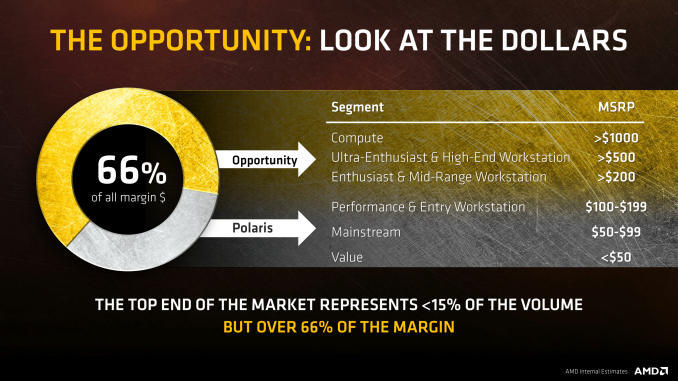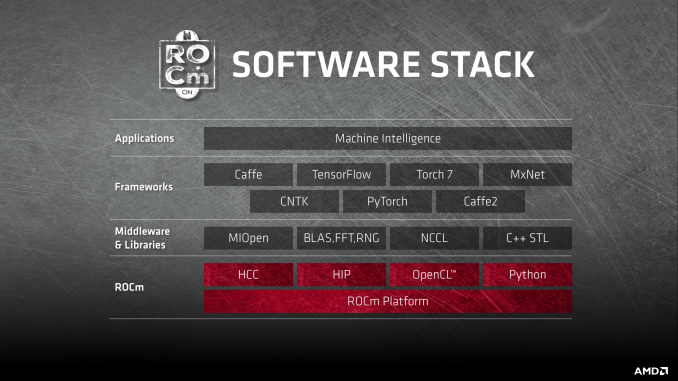AMD Unveils the Radeon Vega Frontier Edition: Vega Starts in the Pros
by Ryan Smith on May 17, 2017 2:45 AM EST- Posted in
- GPUs
- AMD
- Radeon
- Machine Learning
- Vega
- Radeon Pro
- Vega Frontier Edition
Vega Frontier Edition’s Target Market: AI, Machine Learning, and other Professionals
As important as the Vega hardware itself is, for AMD the target market for the hardware is equally important if not more. Vega’s the first new high-end GPU from the company in two years, and it comes at a time when GPU sales are booming.
Advances in machine learning have made GPUs the hottest computational peripheral since the x87 floating point co-processor, and unfortunately for AMD, they’ve largely missed the boat on this. Competitor NVIDIA has vastly grown their datacenter business over just the last year on the back of machine learning, thanks in large part to the task-optimized capabilities of the Pascal architecture. And most importantly of all, these machine learning accelerators have been highly profitable, fetching high margins even when the cards are readily available.
For AMD then, Vega is their chance to finally break into the machine learning market in a big way. The GPU isn’t just a high-end competitor, but it offers high performance FP16 and INT8 modes that earlier AMD GPU architectures lacked, and those modes are in turn immensely beneficial to machine learning performance. As a result, for the Vega Frontier Edition launch, AMD is taking a page from the NVIDIA playbook: rather than starting off the Vega generation with consumer cards, they’re going to launch with professional cards for the workstation market.
To be sure, the Radeon Vega Frontier Edition is not officially branded as a Pro or WX series card. But in terms of AMD’s target market, it’s unambiguously a professional card. The product page is hosted on the pro graphics section of AMD’s website, the marketing material is all about professional uses, and AMD even goes so far as to tell gamers to hold off for cheaper gaming cards later on in their official blog post. Consequently the Vega FE is about the closest analogue AMD has to NVIDIA’s Titan series cards, which although are gaming capable, in the last generation they have become almost exclusively professional focused.
AMD launching a new GPU architecture in the professional space first is a very big deal. Simply put, the company has never done it before. Fiji, Hawaii, Tahiti, Cayman, Cypress, and more all launched in consumer cards first. The traditional wisdom here is that launching in the consumer space first allows consumers to get their hands on the cards now, while professional products undergo further validation and refinement to meet the higher standards of professional users. Put another way, consumers serve as the final layer of debugging a new GPU, offering mass testing unlike anything else. So for AMD to launch in the pro market first indicates that they have an extensive amount of faith in the product.
As for why AMD would want to do this, the following AMD slide says it all.
Simply put, professional cards sell for higher prices than consumer gaming cards, sometimes significantly higher. As a result it makes all the sense in the world to sell their first Vega cards to professional users who are willing to pay $1000+ for a compute card, as opposed to consumers who would like to pay half that. More than anything else, AMD’s overall lack of profitability has come from a lack of high-margin parts to help offset their ongoing operational costs, and launching Vega as a pro card is one of the steps AMD is taking to correct that.
For pro users then with sufficiently deep pockets, they’ll be the first to get a crack at AMD’s latest high-end video card/accelerator. AMD calls this line of cards the Frontier Edition, and while the name is clearly AMD being cheeky towards NVIDIA’s Founder’s Edition line, the analogy isn’t completely off-base. AMD’s target market is going to be machine learning developers, game developers, and others who AMD believes need early access to the cards for future development. The advantage of this route is that, particularly in the case of machine learning, this allows developers to get a jump on testing a new architecture ahead of placing a large order for server cards. So in a sense, one of the roles of the Vega FE is to prime the pump for selling Radeon Instinct MI25 cards later in the year.
As for consumers, while this is as big a change for them as it is for AMD, it’s likely a hallmark of what to expect in the future for new high-end GPU launches. For AMD gamers who have been holding out for Vega, it’s clear that they’ll have to hold out a bit longer. AMD is developing traditional consumer gaming cards as well, but by asking gamers to hold off a little while longer when the Vega FE already isn’t launching until late June, AMD is signaling that we shouldn’t be expecting consumer cards until the second half of the year.
Wrapping things up, it’ll be very interesting to see how this strategy goes for AMD. NVIDIA has been very successful in the machine learning market over the last year, and if AMD can replicate NVIDIA’s success, not only will they make the machine learning market far more competitive for everyone, but they also stand a very good chance of finally turning the corner on both profitability and their overall share of the HPC market.













134 Comments
View All Comments
peevee - Wednesday, May 17, 2017 - link
"NVIDIA has 10,000 employees, and they don't have thousands of them sitting around doing nothing."But nVidia also has more markets to serve, their have their own CPUs, mobile, automotive...
And I wonder what percentage of those employees are engineers.
Yojimbo - Thursday, May 18, 2017 - link
"But nVidia also has more markets to serve, their have their own CPUs, mobile, automotive..."It's AMD that have their own CPUs, not NVIDIA. But I didn't include AMD's CPU business in their employee count. NVIDIA is rather focused. Virtually all their products are based on their GPU architecture. They do develop their own CPU core based on the ARM-v8 instruction set, but it is geared entirely for one purpose, to be the CPU for their self-driving car SoC. Mobile and automotive are close to the same market for NVIDIA. They probably put 100 employees or something on the Switch. NVIDIA have gaming GPUs, professional GPUs, datacenter, and Tegra (mobile/automotive). AMD are trying to go after all that same stuff other than automotive. Whatever number of employees NVIDIA use on the Switch, AMD probably use more on the XboX/PS4 projects.
NVIDIA have 3 times the numbers of employees as RTG. NVIDIA don't have 2/3 of their employees working on mobile and automotive. Most likely they have well under 1/3. Let's be conservative and place it at 1/3. That means NVIDIA have roughly twice the number of employees working on the other segments, about 3,000 people. No, they aren't all engineers, but AMD's 3,000 aren't all engineers, either. NVIDIA don't have 3,000 extra support employees that AMD don't need. NVIDIA's margins show that their business is not inefficient. A good number of those employees are working on basic software libraries (CUDA libraries), integration of their products into deep learning frameworks, and vertical integration for various market segments: gaming, healthcare, financial services, manufacturing, etc. These efforts aren't just fluff. They are critical to leveraging NVIDIA's hardware into these various segments.
hammer256 - Thursday, May 18, 2017 - link
I think I remember reading that Nvidia has more software engineers than hardware people. Knowing how much effort they put into their software stack, makes a lot of sense.When AMD released their first GCN, I commented that they really need to put down some serious effort driving the software support. Let's see what they do this time...
1mpetuous - Wednesday, May 17, 2017 - link
And CUDA is what it comes down to for me. I'm in that semi-pro subset for which $1-2k for a GPU is not unreasonable if it reduces the runtime of my algorithms by 30-40%. But having to rewrite and validate all my CUDA/Matlab code to use OpenCL is a deal breaker, even if AMD halves the price/perf ratio. Converting people in my situation is the hole that AMD needs to climb out of to succeed at compute, not just make faster/cheaper cards.Haawser - Friday, May 19, 2017 - link
Why not use HIP ? https://github.com/GPUOpen-ProfessionalCompute-Too...tuxRoller - Wednesday, May 17, 2017 - link
Opencl's with is getting better. Yesterday opencl 2.2 was released. That includes c++ as a first class citizen support, an update for their standard ir format (c++ support and runtime optimization, the will be very helpful for one of the big problems with opencl), and the official opencl compliance suite and specification had also been made freely available.A number of the big ml frameworks (tf, caffe, touch) either have or are working on openCL implementations.
Yojimbo - Wednesday, May 17, 2017 - link
The high bandwidth cache looks interesting. I wonder if it will make it more difficult to program for, however. The VRAM is pretty slow.I went to Baidu's DeepBench site and didn't find the info related to Vega. My stream spazzed out and I missed some of what Koduri said when he was showing the benchmark. I wonder if the benchmark chosen makes good use of the high bandwidth cache. His graphic just says "time to complete DeepBench", but DeepBench consists of four different tests and each one can have vastly different configurations of the underlying matrices, networks, etc. (whatever is being used for that particular test). From what I see on the DeepBench site, his graphic doesn't mean much on its own. AMD always seems to pull that shit and it's getting annoying.
Koduri said that Vega was first coming in the terms of this Frontier GPU, which was geared towards professionals and machine intelligence (although it's not the already announced Radeon Instinct MI25 even though it seems to fit its specs). Does that mean that consumer Vega will follow later, or will consumer Vega be announced at a later time and still arrive in June?
vladx - Wednesday, May 17, 2017 - link
Unfortunately cherry-picking is what AMD knows to do best.tamalero - Wednesday, May 17, 2017 - link
both companies have done so. AMD isnt the only one.At least AMD hasnt cheated in benchmarks like intel has done in the past (by disabling optimizations and multicore on AMD cpus for their tests for example) or reduced texture quality to shit levels to be on par (old Nvidia cards)
vladx - Wednesday, May 17, 2017 - link
And yes, the article states the consumer Vega will almost surely launch sometime in the second half of the year.